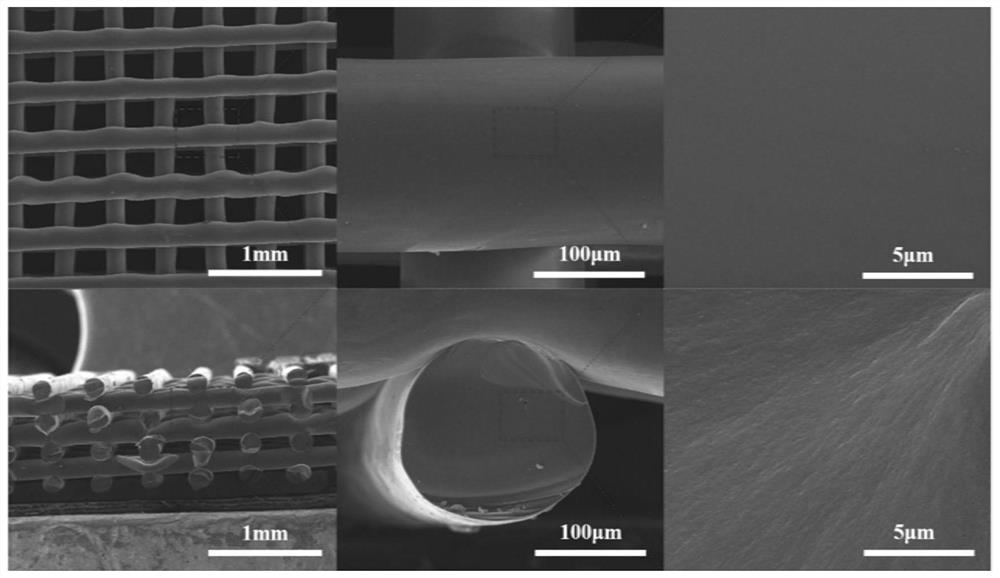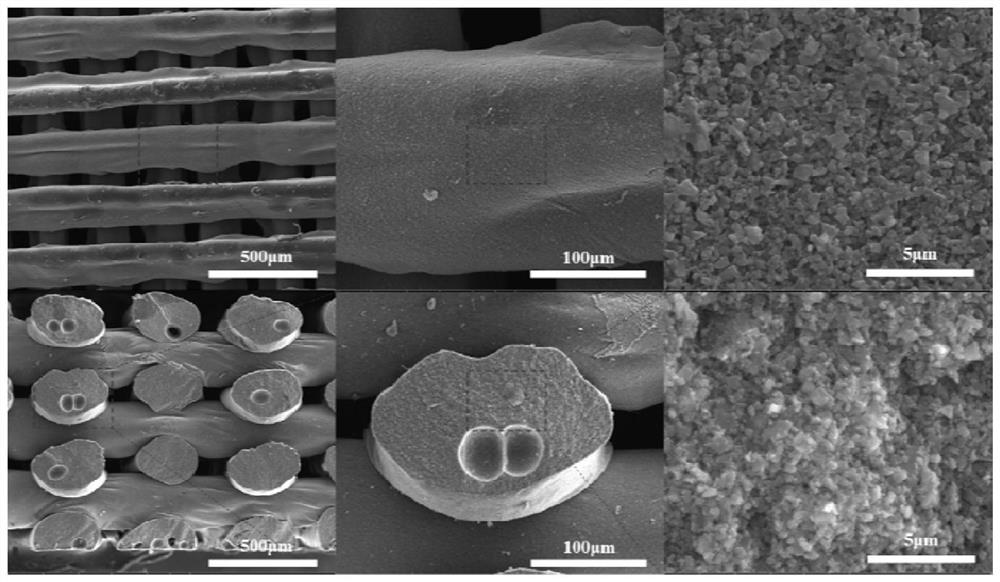Molten 3D direct-writing printing slurry as well as preparation method and application thereof
A molten state, 3D technology, applied in the field of 3D printing materials, can solve problems such as difficult control of slurry rheological properties, achieve the effects of avoiding a large number of cracks, simple preparation method, and improving brittleness
- Summary
- Abstract
- Description
- Claims
- Application Information
AI Technical Summary
Problems solved by technology
Method used
Image
Examples
Embodiment 1
[0037] Using polycarbosilane / polypropylene powder as slurry and air as crosslinking gas, a three-dimensional ceramic structure was prepared.
[0038] Put 6g of polycarbosilane, 0.3g of polypropylene, and 1000ml of xylene into a beaker, and stir magnetically in an oil bath at 120°C for 6h. Then the clear and transparent solution was transferred to a vacuum drying oven, the temperature was set at 120°C, the pressure was -0.1MPa, and vacuum-dried for 24 hours to obtain uniformly blended polycarbosilane / polypropylene particles, the powder was ground and sieved to obtain straight Write with slurry. The screen mesh is 100 mesh.
[0039] Put 5g of polycarbosilane / polypropylene powder into a stainless steel syringe, install a 200μm aperture needle on the top of the syringe, install a heating jacket outside the syringe, assemble the piston and air guide tube, and inject 99.999% high-purity gas into the syringe. Nitrogen, the pressure is set to 60psi, keep 10min, remove the air in the...
Embodiment 2
[0047] Using polycarbosilane / polypropylene powder as slurry and air as crosslinking gas, a three-dimensional ceramic structure was prepared.
[0048] Put 4g of polycarbosilane, 0.12g of polypropylene, and 50ml of xylene into a beaker, and stir magnetically in an oil bath at 120°C for 4h. Then the clear and transparent solution was transferred to a vacuum drying oven, the temperature was set at 120°C, the pressure was -0.1MPa, and vacuum-dried for 12 hours to obtain uniformly blended polycarbosilane / polypropylene particles, the powder was ground and sieved to obtain a direct Write with slurry. The screen mesh is 100 mesh.
[0049] Put 2g of polycarbosilane / polypropylene powder into a stainless steel syringe, install a 200μm aperture needle on the top of the syringe, install a heating jacket outside the syringe, assemble the piston and air guide tube, and inject 99.999% high-purity into the syringe. Nitrogen, the pressure is set to 50psi, keep 10min, remove the air in the syri...
Embodiment 3
[0057] Using polycarbosilane / polypropylene powder as slurry and air as crosslinking gas, a three-dimensional ceramic structure was prepared.
[0058] Put 4g of polycarbosilane, 0.04g of polypropylene, and 50ml of xylene into a beaker, and stir magnetically in an oil bath at 120°C for 4h. Then the clear and transparent solution was transferred to a vacuum drying oven, the temperature was set at 120°C, the pressure was -0.1MPa, and vacuum-dried for 12 hours to obtain uniformly blended polycarbosilane / polypropylene particles, the powder was ground and sieved to obtain a direct Write with slurry. The screen mesh is 100 mesh.
[0059] Put 2g of polycarbosilane / polypropylene powder into a stainless steel syringe, install a 400μm aperture needle on the top of the syringe, install a heating jacket on the outside of the syringe, assemble the piston and air guide tube, and inject 99.999% high-purity into the syringe. Nitrogen, the pressure is set to 50psi, keep 10min, remove the air i...
PUM
| Property | Measurement | Unit |
|---|---|---|
| diameter | aaaaa | aaaaa |
| diameter | aaaaa | aaaaa |
| diameter | aaaaa | aaaaa |
Abstract
Description
Claims
Application Information
 Login to View More
Login to View More - R&D
- Intellectual Property
- Life Sciences
- Materials
- Tech Scout
- Unparalleled Data Quality
- Higher Quality Content
- 60% Fewer Hallucinations
Browse by: Latest US Patents, China's latest patents, Technical Efficacy Thesaurus, Application Domain, Technology Topic, Popular Technical Reports.
© 2025 PatSnap. All rights reserved.Legal|Privacy policy|Modern Slavery Act Transparency Statement|Sitemap|About US| Contact US: help@patsnap.com


